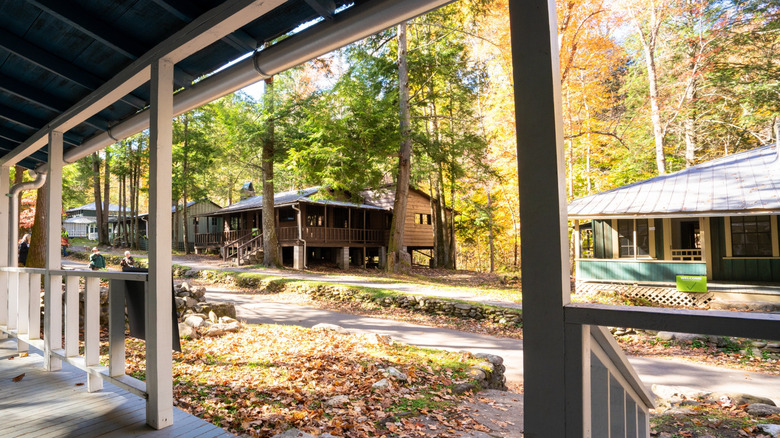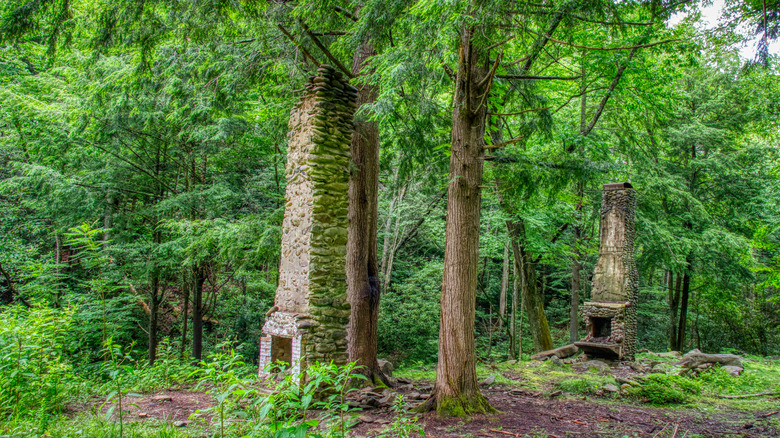The Creepiest Destination In The Smoky Mountains Is An Eerie But Beautiful Resort Ghost Town
Who among us isn't fascinated by an abandoned place? What happened? Who lived here? Why did they leave? Was it a tragedy? Or just the end of an era? It's enough to make imaginations run wild. Consider how many scary movies begin with a spooky abandoned house at the edge of town or the discovery of a well buried for decades beneath layers of debris. Even places in the open — Stonehenge (the ancient sanctuary in southern England dates back to Neolithic times) and Machu Picchu (a surprisingly perfect vacation destination for seniors) — beg the questions, who, what, when, and why. There's a place in the Great Smoky Mountains — an eerily appealing ghost town — that triggers that same kind of spine-tingling curiosity.
Located adjacent to Elkmont Campground in Elkmont, Tennessee, about eight miles from Gatlinburg (one of the most budget-friendly destinations in America), Elkmont Ghost Town is what remains of a once-bustling early-20th-century resort village. But it didn't start out that way. Established in the mid-1800s by homesteaders and trappers, the region's bounty of ash, poplar, hemlock, and cherry trees eventually caught the eye of the logging industry.
By 1907, the Little River Lumber Company had officially established operations in the town of Elkmont and built a railroad to transport freshly cut trees to Knoxville for processing. Ironically, the railroad built to support the logging operation also drew the attention of outsiders who appreciated the region's natural beauty. Recognizing an opportunity to create a second income stream, the Little River Logging company sold 50 acres of cleared land to the Appalachian Club — a newly minted social club founded by Knoxville movers and shakers — for the purpose of building a vacation resort.
A metamorphosis from logging town to vacation resort
Shortly thereafter, Charles B. Carter, a local entrepreneur, jumped on the gravy train. He purchased 64 acres of land from the Little River Company and built his own resort, the Wonderland Club. For decades, the resort communities at the Appalachian Club and the Wonderland Club reigned as places to see and be seen. Both featured individual cabins built around a central clubhouse that served as the social hub, hosting seasonal parties and dances for club members.
We're guessing the vibe may have been similar to the fictional Steiner Mountain Resort featured on season 2 of Amazon's hit show, "The Marvelous Mrs. Maisel". During the height of its success, Col. David Chapman, a founding member of The Appalachian Club and early conservationist, began courting interest in establishing a state park in the Great Smoky Mountains. Chapman's lobbying efforts paid off, leading to the 1934 establishment of Smoky Mountain National Park, one of the best US national parks for camping.
Even though the new park's boundaries encompassed the land occupied by The Appalachian Club and The Wonderland Club, both remained open for quite a while. Ultimately, World War II heralded their end. The Wonderland Club downsized, staying open until 1992 as a rustic hotel, but the Appalachian Club completely ceased operations by 1950. In an interesting twist, the National Park Service accommodated cabin owners who wanted to stay, purchasing the property at 50% of market value while granting them lifetime leases. The contracts were renegotiated in 1952 to 20-year leases, then extended in 1972 for another 20 years, but the arrangement ended in 1992.
Eerie ruins punctuate the landscape
As the leases expired, families began the sad process of leaving the vacation homes that had been their woodland sanctuaries for generations. The original plan was to raze the communities, but in 1994 a Hail Mary pass saved the site when the remaining structures were listed on the National Register of Historic Places. Not only did the NRHP listing save the remaining structures, it required the National Park Service to come up with a plan to preserve what was left. Remains today include 19 original buildings and The Appalachian Club's clubhouse.
The Robert Trentham Cabin, built by Levi Trentham in 1845, is the oldest structure in the designated historic district. Open to the public, it features period furniture and offers a look at mid-18th-century plumbing. Deeper into the woodlands, a stroll along Little River Trail or Jakes Creek Trail passes by the eerie remains of long-gone cabins. Remnants of stone chimneys, walls, and foundations punctuate the landscape. Is it haunted? Some visitors report experiencing an eerie presence and there is a historic graveyard on-site.
There's only one way to find out. Tune up your spidey sense and take a stroll through history. Admission is free. A walking trail begins at the ranger station near the adjacent campground. If you're flying in for a visit, the closest major gateway is McGhee Tyson Airport (TYS) in Knoxville, Tennessee. In addition to Elkmont Campground, lodging options include a full roster of hotels, motels, inns, and rentals. For a unique experience, check out Sanctuary Treehouse Resort in nearby Sevierville.


